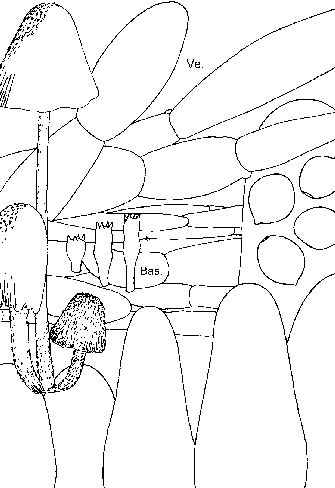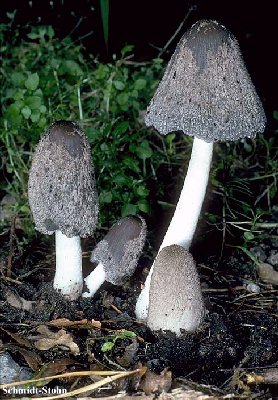Macroscopic features |
Pileus up to 50 x 30 mm when still closed, up to c. 60 mm when expanded, first ellipsoid, cylindric-ellipsoid, pale to dark grey-brown at centre beneath the whitish to silvery grey veil, paler to margin, expanding to conical, then to convex or applanate, finally plano-concave with revolute margin. Veil first white, later grey to grey-brown (Mu. 10 YR 4-5/3) and radially splitting up into hairy to fibrillose, often pointed and adpressed or - especially at centre - recurved flocks, the tips becoming brown on drying. Lamellae, L = c. 55-80, l = 3-7, free, narrow, rather crowded, first white, soon greyish brown to blackish. Stipe 50-130 x 3-10 mm, whitish, somewhat tapering towards apex, up to 13 mm wide at clavate to bulbous base, hollow, hairy flocculose over the whole surface but particularly densely at lower part, becoming glabrous with age. |
Microscopic features |
Spores [100/5/4] 6.7-9.7 x 5.8-8.2 µm, ellipsoid or ovoid, seldom somewhat cylindrical, with rounded base and apex, and central, c. 1.4 -1.7 µm wide germ pore, dark reed-brown under microscope; Q 1.05-1.35, av. Q = 1.15-1.30; av. L = 7.2-8.7, av. B = 6.2-7.3 µm. Basidia 16-40 x 7-9 µm, 4-spored, surrounded by 3-6 pseudoparaphyses. Pleurocystidia 50-140 x 20-55 µm, subglobose, ellipsoid to oblong, utriform or subcylindrical. Cheilocystidia 35-85 x 15-50 µm, (sub)globose, ellipsoid to oblong. Pilei- pellis hyphoid. Veil made up of elongate, sausage-like elements, 50-180 x 15-40 µm, often inflated, usually constricted at septa; terminal cells cylindrical to almost globose. Clamp-connections present, small. |
Habitat & distribution |
Common. Growing solitary or fasciculate on heaps of mixed dung, rotten straw or vegetable refuse, less frequent on pure dung. Wide-spread all over the world. |
Remarks |
Karsten described Coprinus lagopides twice, in 1879 and 1882. The first time (P. Karst., l.c.) the type shows ornamented spores, similar to those of Coprinus phlyctidosporus. The second collection described by Karsten (P. Karst., 1882) is identical to the species as general accepted by modern mycologists. |

[Copyright © by Uljé]

[Copyright © by Schmidt-Stohn]